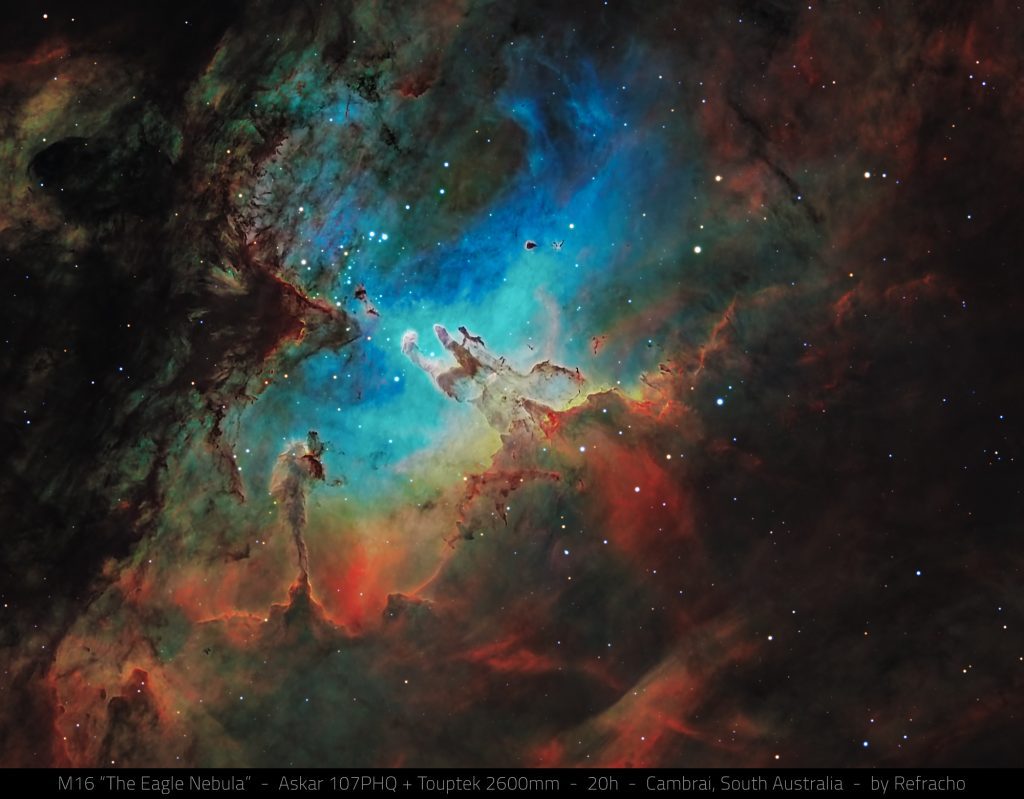Introduction to M16: The Eagle Nebula
Located approximately 7,000 light-years away in the constellation Serpens, Messier 16 (M16), or the Eagle Nebula, is a spectacular star-forming region within the Milky Way. Discovered by Jean-Philippe de Chéseaux in 1745 and cataloged by Charles Messier in 1764, M16 is home to young, hot stars, glowing hydrogen gas, and dark, dusty regions.
At its core lies the open star cluster NGC 6611, whose energetic radiation shapes the surrounding nebula and powers its glow. The nebula spans roughly 70 light-years across and offers a dramatic showcase of stellar evolution in action.
The region gets its nickname “Eagle Nebula” due to the shape of the dark dust lanes that resemble a bird with outstretched wings when viewed through telescopes.
The Pillars of Creation in Astronomy and Astrophotography
At the heart of M16 lies one of the most iconic celestial structures ever imaged — the Pillars of Creation. These massive towers of gas and dust, each stretching several light-years long, are sculpted by the intense radiation and stellar winds from nearby massive stars. Within these columns, protostars are forming, hidden behind dense clouds of molecular gas. These pillars are a classic example of triggered star formation, where new stars form as the expanding shockwaves from previous generations compress surrounding material.

A History of Iconic Observations
The 1995 image taken by the Hubble Space Telescope brought the Pillars of Creation into public consciousness. Captured using narrowband filters (Hα, OIII, SII), the image showed fine detail and dramatic contrast that made it a staple of scientific communication and a poster child for space exploration.
In 2022, the James Webb Space Telescope (JWST) revisited the Pillars of Creation using its NIRCam instrument. The result was a revolutionary high-resolution infrared view, unveiling newborn stars that were previously hidden in dust. JWST’s image complements Hubble’s view by showing both the structure and the ongoing star formation processes inside. Together, these views highlight the multi-wavelength beauty and complexity of this region.
For astrophotographers, the Pillars of Creation are not just a scientific curiosity — they are a symbol of what’s possible with modern imaging, even from Earth.
Imaging M16 – Practical Considerations for Astrophotographers
While the Pillars of Creation are only a small part of M16, capturing them in high detail is a rewarding challenge that tests your equipment, planning, and processing skills.
Framing the Target
To isolate the Pillars of Creation, you’ll need a focal length of at least 700mm, though 1000mm+ is ideal. Shorter focal lengths can still capture the Eagle Nebula as a whole but may lack the resolution needed to resolve fine detail in the pillars themselves.
Filter Choice and Signal Acquisition
- Narrowband Imaging (Hα, OIII, and optionally SII) is recommended due to the nebula’s emission-line nature and its low surface brightness.
- M16 is rich in hydrogen-alpha (Hα) signal, and also shows strong OIII contrast around the pillars.
- An effective HOO or SHO composition brings out the fine textures and highlights the star-forming regions.
Recommended total integration time:
- At least 10–15 hours for SHO (Hα, SII, OIII)
- 6–10 hours for HOO (Hα, OIII)
- Use 3nm filters if imaging under light-polluted skies
Data Processing Strategy
Here’s a suggested post-processing outline in PixInsight:
- Calibration + CosmeticCorrection + WeightedBatchPreprocessing
- DynamicCrop, ABE/DBE to remove gradients
- Image Registration (StarAlignment) and Image Integration
- Linear noise reduction (MLT or EZ Denoise)
- Star removal (StarXTerminator)
- Stretching via HistogramTransformation or GHS
- Color combination (PixelMath HOO/SHO formula or NBRGBCombination)
- Local contrast enhancement (LocalHistogramEqualization, HDRMT)
- Color refinement using ColorMask or CurvesTransformation
- Star reintegration, optional star color boosting
Bonus: If you aim for a JWST-inspired aesthetic, you can reduce green hues and emphasize OIII’s cool tones for a more “infrared-look” palette.
Discover more from Junrui Ye Blog
Subscribe to get the latest posts sent to your email.